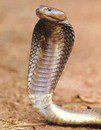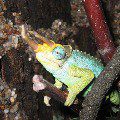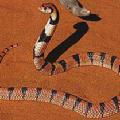
King Cobra
The king cobra or hamadryad (lat. Ophiophagus hannah) is the largest venomous snake in the world. Individual specimens can reach a length of up to 5,5 m, the average size of an adult cobra is 3-4 meters. Despite the name, the king cobra does not belong to the genus of true cobras, it stands out in the independent genus Ophiophagus. The venom of this snake is mainly neurotoxic, the snake bite is fatal. The frequency of death after a bite exceeds 75%. However, in most cases, the snake injects an amount of poison that is not enough to kill a person. There are cases when this snake, trying to scare away a person, made “idle” bites without injecting poison at all.
Classification
 Kingdom: Animalia (animals)
Kingdom: Animalia (animals)
Type: Chordata
Class: Reptilia (reptiles)
Order: Squamata (scaly)
Suborder: Serpentes (snakes)
Family: Elipidae (aspididae)
Rod: Ophiophagus
Species: Ophiophagus hannah (king cobra, or hamadryad)
Inhabitation
 The king cobra lives in Southeast Asia. Inhabits India south of the Himalayas, Indochina, Malacca, South China, Philippines, Greater Sunda Islands to Bali. Meet her in the wooded areas. Selects areas with grassy cover and dense undergrowth, although it is also found in developed areas. This snake climbs trees well, swims remarkably, although it still spends most of its time on the ground.
The king cobra lives in Southeast Asia. Inhabits India south of the Himalayas, Indochina, Malacca, South China, Philippines, Greater Sunda Islands to Bali. Meet her in the wooded areas. Selects areas with grassy cover and dense undergrowth, although it is also found in developed areas. This snake climbs trees well, swims remarkably, although it still spends most of its time on the ground.
Description
 The Hamadryad is the world’s largest venomous snake. The average size of an adult is 3 m, but records were also recorded – 5 m. On the head of the king cobra, behind the occipital scutes, there are six additional large scutes in a semicircle. The color of the body is yellowish-green with black rings, which are often narrow and indistinct on the front of the body, and become wide and bright towards the tail. However, due to the vast habitat, the color of the king cobra is quite variable.
The Hamadryad is the world’s largest venomous snake. The average size of an adult is 3 m, but records were also recorded – 5 m. On the head of the king cobra, behind the occipital scutes, there are six additional large scutes in a semicircle. The color of the body is yellowish-green with black rings, which are often narrow and indistinct on the front of the body, and become wide and bright towards the tail. However, due to the vast habitat, the color of the king cobra is quite variable.
Leads a daily lifestyle. Juveniles are more brightly colored than adults.
The cobra sheds 4 to 6 times a year. The molting period lasts about 10 days.
The poison of the king cobra is very strong. Its power can be enough to cause death in a human within half an hour. However, more often than not, the snake makes “idle” bites, injecting no venom at all to scare away the person. This is most likely due to the fact that, first of all, the cobra needs poison for hunting, and its accidental loss is undesirable.
Food
The king cobra hunts mainly for snakes, which make up the bulk of its diet. Along with non-poisonous ones, poisonous individuals such as kraits (the genus Bungarus), cobras (the genus Naja), and decorated asps (the genus Calliophis) can also become its victims. Occasionally, she can diversify her diet with large lizards.
It is because of its diet, consisting mainly of its own kind, that the king cobra got its scientific name Ophiophagus hannah (“snake eater”).
A cobra can go without food for about three months – the time it spends on the inseparable protection of its egg laying.
Reproduction
 When confronted in the same territory, males can arrange ritual fights among themselves, while not biting each other. With the female, of course, the winner remains. Before mating, the male takes care of the female for some time, thereby making sure that she does not pose a danger to him. After this, mating itself takes place, which lasts about an hour. The female will be ready to lay eggs in about a month. Preparing to lay eggs, the king cobra builds a special “nest” by raking dry leaves and branches into a rounded pile with the front part of the body. The number of eggs in a clutch varies from 20 to 40. Basically, the female guards the clutch, first covering it with leaves from above and placing it on top, but sometimes the male also takes part in guarding the nest. The incubation period is about 100 days. Shortly before the birth of the cubs, the female leaves the nest to find food so as not to eat her own offspring. After birth, the cubs will stay near the nest for about a day, eating the remaining egg yolk.
When confronted in the same territory, males can arrange ritual fights among themselves, while not biting each other. With the female, of course, the winner remains. Before mating, the male takes care of the female for some time, thereby making sure that she does not pose a danger to him. After this, mating itself takes place, which lasts about an hour. The female will be ready to lay eggs in about a month. Preparing to lay eggs, the king cobra builds a special “nest” by raking dry leaves and branches into a rounded pile with the front part of the body. The number of eggs in a clutch varies from 20 to 40. Basically, the female guards the clutch, first covering it with leaves from above and placing it on top, but sometimes the male also takes part in guarding the nest. The incubation period is about 100 days. Shortly before the birth of the cubs, the female leaves the nest to find food so as not to eat her own offspring. After birth, the cubs will stay near the nest for about a day, eating the remaining egg yolk.
Content
King cobras are rarely seen in zoos, firstly because of their aggressiveness, and secondly because of problems with their diet – they rarely manage to be converted in captivity to feeding on rats. No less often they can be bred.
Additionally
The name “royal” is associated either with its size (up to 5 meters in length), or because of the six shields behind the back of the head, which vaguely resemble a crown.
There are known cases of death after being bitten by an elephant king snake.
King cobras can lift vertically up to a third of the front of their body and even move in this position.
Like the Indian cobra, the king cobra is used by Indian snake charmers and “cobra dances”.
Sources of
http://www.zveryshki.ru
http://ours-nature.ru
http://dic.academic.ru
http://www.equator.ru
http://www.zooclub.ru
http://www.bojtes-zveri.ru
http://www.floranimal.ru
http://www.unbelievable.su





